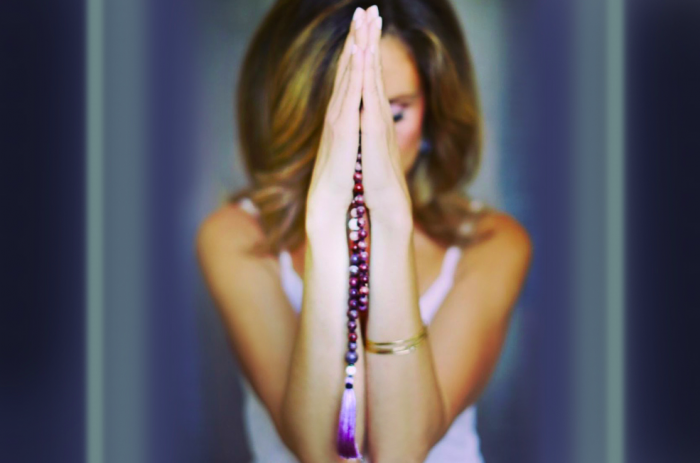Life can seem like a wild and unpredictable roller coaster ride when emotions are running high.
We search for emotional stability in a world of ups and downs, but it can be tough to pencil “serenity” into a chaotic schedule. Many of us really want to incorporate peaceful practices like yoga into our week as stress management, but it’s not always possible.
My own struggle with the “daily grind” is how I ended up on the path to discovering “emotional flexibility.”
I remember when I reached the end of my rope while building my business and raising four kids under the age of seven. I felt torn in a million different directions with a flurry of driving to and from schools and doctor’s appointments, checking homework, developing a brand, managing my client load, and working on my spiritual development. It was a juggling act and I needed some way to de-stress while keeping all the balls in the air.
I knew I always felt rejuvenated after squeezing in a yoga session and so decided to find a way to create an “inner yoga” that I could do when I felt like pulling my hair out in the after-school pickup line or when the kids wanted four different breakfasts.
One of the hallmarks of yoga is the ability to help stagnant energy flow in the body. Similar to the stiff, achy situation I found myself in when I didn’t stretch my body—I learned that when I ignored the need to let my emotions “flow,” I would suffer for it.
I realized I was happiest when I didn’t fight my emotions, repress them, or ignore them. When I embraced them lovingly, that’s when I began to transcend stress and emotional blocks. That’s when the best chapters of my life began to unfold.
To achieve results like that took serious practice. Just as it takes training and many attempts to master a yoga pose—mastering emotional flexibility takes similar dedication. Starting out, there’s some guaranteed clumsy moments and difficulty understanding—but it’s all part of the process.
Here’s the three-step process I developed for my emotional flexibility journey that helped me get on my way to emotional balance and flow.
Heart connection.
Think of the heart as the bridge between body and mind, built with awareness and self-compassion. When we connect to our heart, it’s not only soul-satisfying, but it helps us process emotions through a filter of love rather than fear. This is uncharted territory for many of us stuck living in our heads, but it’s fertile ground for nurturing self-compassion.
Here are some of the techniques that helped me renew the connection to my heart.
Heart centered living. This ensures we’re living life to the fullest and enjoying ourselves—not just existing. Plugging into our hearts gives us the spark we need to move through emotional blocks and renew positive energy flow when we’re feeling depleted.
Connecting to the heart can be as simple as consciously enjoying a pleasant moment in the day, like watching the sunset. During a busy day, I like to stay alert for these moments, notice the warmth rising in my chest, pausing to really feel it and let it wash over me in a wave of positivity.
Heart focused breaths. These are a well-studied way to reach a neutral emotional state when we’re trying to come out of a negative funk. To try this yourself, simply imagine your inhales and exhales flowing through your heart center as you disconnect from negative thoughts. Doing this, we can make an energetically charged choice to disengage from the stress-response inducing patterns and enter a more harmonious state.
Expressing yourself authentically. This is one of the most expansive practices we can use to tap into the power of heart connection. Many of us get so tied up in the rat race that we forget who we are at our core. Taking time for introspection to discover ourselves in a new way is a magical practice.
Think of it as connecting to the breath during yoga practice. When we find our natural rhythm, without worrying about what anyone else is doing, it’s easier to flow through each posture (or emotional challenge) with unique elegance and ease.
Nurture healthy relationships.
Just as we may be more likely to stick with yoga practice in a class format, emotional flexibility is best developed in a judgment-free communal environment. “Finding your tribe” immerses you in an experience more than you could ever accomplish alone.
Forging trusting relationships that support your emotional health and give you a safe space to share your feelings is a terrific outlet for reinforcing a positive attitude and fostering emotional resilience.
Here are two keys to attracting an ideal tribe:
Ditching toxic emotional attachments. This frees us from the tangled web of unhealthy relationships with people (friends, family, coworkers), places (unfulfilling jobs, toxic home environments), and things (addictions, overspending). This is especially needed if the attachment has been a demanding, abusive, or draining presence.
It’s important to get to the root of what went wrong when we recognize a toxic presence in life. Then we can find the closure needed and cut ties. Professional help is recommended.
Practicing vulnerability. This is necessary for forming meaningful relationships. Our fast-paced, digital world leaves us starved for genuine connection. We can make it a point to speak up and be honest with people, whether that means telling a loved one how we really feel or paying a compliment to a stranger.
Stripping away the mask we wear for acceptance and protection is both an intense transformation and a gentle undoing—like the level of trust necessary to perform a backbend in yoga. When we do this, we are finally able to work through insecurities and create sincere, healthy bonds with others.
Release resistance.
When we pull up an old wound in our emotional memory bank, our body produces the same chemicals as when the event happened—essentially causing us to relive the trauma over and over again. The effect this has on the nervous system is an incredible burden and can result in chronic conditions like obesity, depression, ulcers, and sleep dysfunction.
It’s essential not to repress emotions, so I’ve found that processing them in the following ways can really support emotional flexibility.
Let it go. Such a beautiful and straightforward instruction—similar to the powerful mantras in yoga practice. When we feel resistance to processing an emotion or notice our mind defaulting to a negative thought spiral, we can simply ask, “Will this matter in 10 minutes, 10 weeks, or 10 years?”
Questioning the impact of our emotional responses and taking an active role in influencing their power over our experiences is a profound way to grow and make tangible emotional flexibility progress.
Do the work. We need to do the work to get to the root cause of unhealthy patterns and past trauma. When we avoid exploring the origin of our issues, it creates obstacles and barriers to emotional growth. Dedicating time to do the work toward releasing resistance in our lives will give us the agency to thrive in new, magnificent ways.
I hope these three steps will help you as much as they did for me. Take it day by day. Start by adding one aspect of one step to your routine and build from there until it feels like second nature. Making it a priority to address disconnects and improve emotional flexibility is a worthwhile pursuit because we are not separate from our emotions.
Just as yoga teaches us to be more grounded and centered in our physical bodies, practicing emotional flexibility gives us the gift of heightened focus, self-awareness, and clarity of purpose.
Caring for our emotional well-being will light the path to sustainable inner peace.
~












Read 8 comments and reply